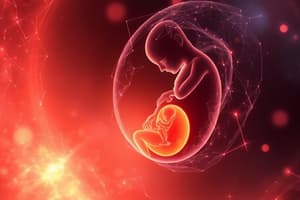Podcast
Questions and Answers
What is maternal recognition of pregnancy?
What is maternal recognition of pregnancy?
It is the establishment of pregnancy involving interactions between the uterus and conceptus.
What is the role of prostaglandin F2 alpha (PGF2α) in non-pregnant animals?
What is the role of prostaglandin F2 alpha (PGF2α) in non-pregnant animals?
PGF2α causes regression of the corpus luteum.
What happens if the conceptus fails to signal its presence?
What happens if the conceptus fails to signal its presence?
- Estrus is terminated
- Luteolysis occurs (correct)
- Pregnancy is maintained
- Progesterone production increases
In pregnant animals, PGF2α is released in an endocrine direction.
In pregnant animals, PGF2α is released in an endocrine direction.
The conceptus must produce __________ hormones and/or proteins to signal its presence to the maternal system.
The conceptus must produce __________ hormones and/or proteins to signal its presence to the maternal system.
What is critical for the establishment of pregnancy in farm animals?
What is critical for the establishment of pregnancy in farm animals?
Match the following species with their respective day of maternal recognition of pregnancy (MRP):
Match the following species with their respective day of maternal recognition of pregnancy (MRP):
What is the antiluteolytic product produced by the sheep conceptus?
What is the antiluteolytic product produced by the sheep conceptus?
Flashcards are hidden until you start studying
Study Notes
Maternal Recognition of Pregnancy (MRP)
- The establishment of pregnancy involves communication between the uterus and the conceptus (embryo and surrounding membranes).
- The conceptus must signal its presence to the maternal system.
- This signal is crucial for maintaining the corpus luteum (CL) function, enabling progesterone production and endometrial development.
- MRP was first described by Short in 1969.
Mechanism of MRP
- If the conceptus fails to signal its presence, the CL will be terminated by prostaglandin F2 alpha (PGF2α) released from the uterus.
- This ensures the female returns to estrus for continued mating until a successful pregnancy is established.
- In non-pregnant animals, PGF2α is released endocrine - meaning it travels through the bloodstream - to cause regression of the CL during the estrus cycle.
- During pregnancy, PGF2α is released exocrine - meaning it acts locally - preventing its luteolytic effect on the CL.
- Luteinizing hormone (LH) is also essential for CL maintenance and function throughout pregnancy.
MRP Timeline in Domestic Animals
- Species | Day of MRP | Day of Definite Attachment ------- | -------- | -------- Cow | 16-17 | 18-22 Ewe | 12-13 | 16 Mare | 14-16 | 36-38 Sow | 12 | 18
MRP in Sheep and Cow
- The conceptus in ewes secretes proteins between days 12 and 21 of pregnancy, inhibiting PGF2α production by the uterine endometrium.
- Luteolysis in ewes involves episodic release of PGF2α between days 14 and 16 of the estrous cycle.
- In pregnant ewes, there are fewer pulses of PGF2α release compared to non-pregnant ewes.
- Estrogen, produced by preovulatory follicles on the ovary, stimulates oxytocin receptors in the uterine endometrium.
- The antiluteolytic factor in ewes is a low molecular weight, acidic protein produced by the conceptus between days 12 and 21 of pregnancy, originally termed ovine trophoblast protein 1 (oTP-1).
- This protein is now classified as a type of interferon and is called ovine interferon-tau.
Studying That Suits You
Use AI to generate personalized quizzes and flashcards to suit your learning preferences.




